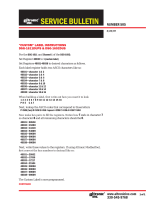
6
Theory of Operation
The detailed set up of the individual circuit parameters
is explained throughout the various sections of this
manual. This Theory of Operation overview is intended
to give a quick summary of how it all works together.
• Parameter setpoints (High/Low Temperature, High/
Low Current & GFEP), Control Modes (Auto or Man-
ual) and operation modes under alarm conditions
(GFEP limit violation & Sensor Loss) are entered for
each circuit. Each circuit is designed to operate in-
dependently.
• Active loops are individually tested for 2 seconds
every 2 minutes. During the test, a current load val-
ue is updated on the yellow bar located on the Main
Window and a new GFEP current is automatically
and continuously calculated.
• If the Ground Fault (GFEP) limit is surpassed, the
ITC has four options of behavior:
1. Alarm, non-latching – No change in output.
2. Alarm and Trip, non-latching – Ouput goes to
0% (off) while in alarm state.
Note (1&2): Alarm will be cleared when sensed GFEP
is 5mA less than GFEP setpoint.
3. Alarm, latching – No change in output.
4. Alarm & trip, latching – Output goes to 0% (off)
while in alarm state.
Note (3&4): Alarm condition may only be cleared with
a manual reset of the alarm
• Similarly, should a failed sensor condition appear,
the ITC will go into alarm state and display a flashing
sensor error. The ITC will automatically be switched
into Manual mode. The output % may be adjusted
by the user within the SYSTEM MENU Parameter:
“Failed Sensor Output 1 (or 2)”. See Temperature
Sensing & Failed Sensor Output parameters in the
System Menu definitions below.
• To limit inrush current on the overall system, a pro-
prietary Soft Start algorithm is applied during sys-
tem start-up. This will ONLY occur while the opera-
tion mode is set to AUTO. The Soft Start program
will increment the output by 1% every 1 second
until the desired temperature is reached or the out-
put % achieves 100%. After the Soft Start program
completes its cycle, the Auto Control Mode of the
system will return to either PID or ON/OFF Control
Mode, depending what was selected by the user.
The Soft Start Program will not function if the control
mode is set to Manual.
Before Powering Up
Chromalox takes great pride in knowing that we have
provided to you a product of premium quality and
workmanship. We have taken every precaution to en-
sure that your equipment arrives safe and secure.
However, vibration and temperature changes during
shipping can cause some components to become
loose. Additionally, throughout the life span of this
product, other environmental and application condi-
tions may have affected the mechanical and electri-
cal continuity of several internal components. There-
fore, for your safety and overall product performance,
please take the time to familiarize yourself with the
MAINTENANCE, OPERATION, AND INSTALLATION
INSTRUCTIONS technical manual that was shipped
with your control product.
Since it is not uncommon for electrical wiring and me-
chanical connections to become slightly loosened dur-
ing shipment, we ask that you pay particular attention
to section 4-5.3:
Wiring and Connections
Check wiring and connections as follows:
a. Inspect wiring for wear, fraying, chipping, nicks, and
evidence of overheating. Repair minor defects with
a good grade of electrical tape, or replace if needed.
b. Inspect for loose electrical and mechanical connec-
tions. Tighten or replace defective crimp-style lugs.
Re-solder loose solder connections. Tighten or re-
place all loose or missing hardware.
These precautions must be adhered to when the prod-
uct is received as well as before every season or on an
annual basis, whichever is shortest.






















